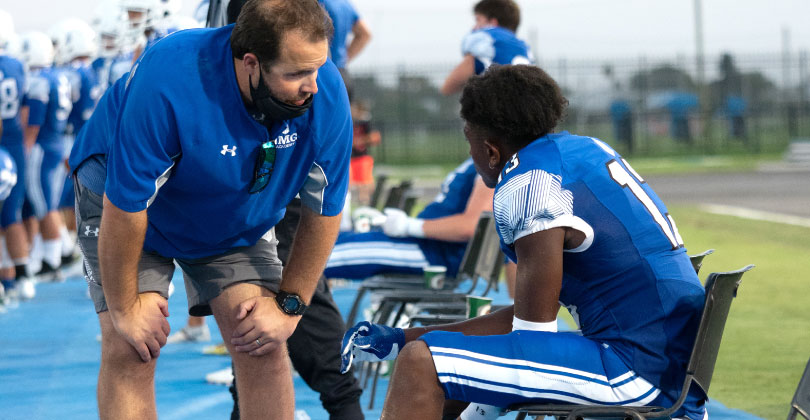What Is a Redshirt Freshman?

A “redshirt freshman” is a college student-athlete who sits out of gameplay their freshman year and begins their first athletic season during their sophomore year. This means a redshirt freshman is an athletic “freshman” and an academic sophomore.
To better understand what redshirt freshman is, let’s take a closer look at the meaning of “redshirt.”
What is a redshirt?
A “redshirt” is a college student-athlete who sits out of gameplay for a season while remaining eligible to compete in four years of college sports. While redshirts don’t play in games against other schools, they can still practice with their team to develop their skills and receive athletic scholarships or financial aid.
The National Collegiate Athletic Association (NCAA) does not use “redshirt” as an official term. However, players and coaches sometimes use the term in Division 1 (D1) and Division 2 (D2) sports.
Why is it called redshirting?
The term “redshirting” likely came from the student-athlete Warren Alfson of the University of Nebraska. In 1937, Alfson asked to practice with the team but not play in any games. Since Nebraska’s team color was red, Warren wore a red shirt without a number. Players and coaches have since called student-athletes who sit out of competitive gameplay for a year “redshirts.”
What is the purpose of redshirting as a freshman?
There are several reasons why a freshman might consider redshirting, including:
- Easing the transition from high school to college
- Enhancing athletic skills before competitive gameplay
- Recovering from a pre-season injury
Easing the transition from high school to college
Becoming a redshirt freshman enables student-athletes to better transition from high school to college life without the pressure of competing right away. Redshirt freshman can spend their first year of college focusing on getting a head start in the classroom while learning the ins and outs of their respective sports and teams from the sidelines.
Enhancing athletic skills before competitive gameplay
Coaches can also benefit from redshirting student-athletes during their freshman year. This gives student-athletes extra time to grow and enhance their athletic abilities before they go toe-to-toe with top-level talent. Coaches may also want to redshirt a freshman student-athlete to extend their eligibility to play college sports.
Recovering from a pre-season injury
Redshirting as a freshman can also benefit student-athletes who become injured before their first competitive season officially begins. This gives a student-athlete two semesters to recover from their injury while maintaining their eligibility to play college sports for four years.
Read more: How to Overcome a Sports Injury During the Recruiting Process
What does the timeline look like for a redshirt freshman?
According to NCAA rules, student-athletes in D1 and D2 schools have five full school years (10 semesters/15 quarters) to complete four years of college sports. This enables student-athletes to “redshirt” any one of their four years in college.
Student-athletes who choose to redshirt their freshman year start competitive gameplay against other teams their sophomore year, which lengthens their eligibility to play in college sports for one year post-graduation (these student-athletes are sometimes referred to as fifth-year seniors).
Redshirting FAQs
Here are some common questions and answers about redshirts and redshirt freshmen.
How common is redshirting as a freshman?
While there are no exact numbers, freshmen student-athletes can redshirt for several reasons, including to ease their transition from high school to college, develop their athletic abilities, recover from a pre-season injury, or extend their eligibility to play in college sports.
Do redshirt freshmen get scholarships?
Yes, redshirt freshmen are eligible to receive athletic scholarships.
Do redshirt freshmen play?
A redshirt freshman plays against competing teams beginning their sophomore year. Being a redshirt freshman means a student-athlete sits out of gameplay during their freshman year. They’re academically a sophomore, but athletically a freshman since their sophomore year is their first year of athletic participation.
However, in Division I football, redshirt freshmen can compete in up to four games against other schools and keep their redshirt status.
Do redshirt freshmen get to travel with the team?
Generally, redshirt freshmen don’t start traveling with their team until they begin competitive gameplay their sophomore year.
How many years can you redshirt?
A student-athlete can be a redshirt for one year. The total number of seasons a student-athlete can compete in college games is four.
Pros of redshirting as a freshman
Two of the main pros of being a redshirt freshman are that student-athletes get a year to build up their athletic skills and focus on college classes. Transitioning from high school to college can be an adjustment, so it might be good for a freshman student-athlete to redshirt to minimize feeling overwhelmed. When a redshirt freshman has a better handle on college life and their athletic abilities in their sophomore year, they can focus their energy on competing.
Cons of redshirting as a freshman
A major con of being a redshirt freshman is that you won’t get to do everything their team does for a year, like play competitive games or travel. Another con is that you must add more training to your schedule, as coaches often expect redshirt freshmen to show improvements from the time they take off to train or heal.
Conclusion
Choosing to redshirt as a freshman has its pros and cons, but it could be a good option for student-athletes who need some extra time to develop their academic and athletic skills, recover from a pre-season injury, or extend their eligibility to play college sports.
Are you interested in the recruiting process? Contact NCSA today to learn more about recruiting and the different types of offers student-athletes can get.